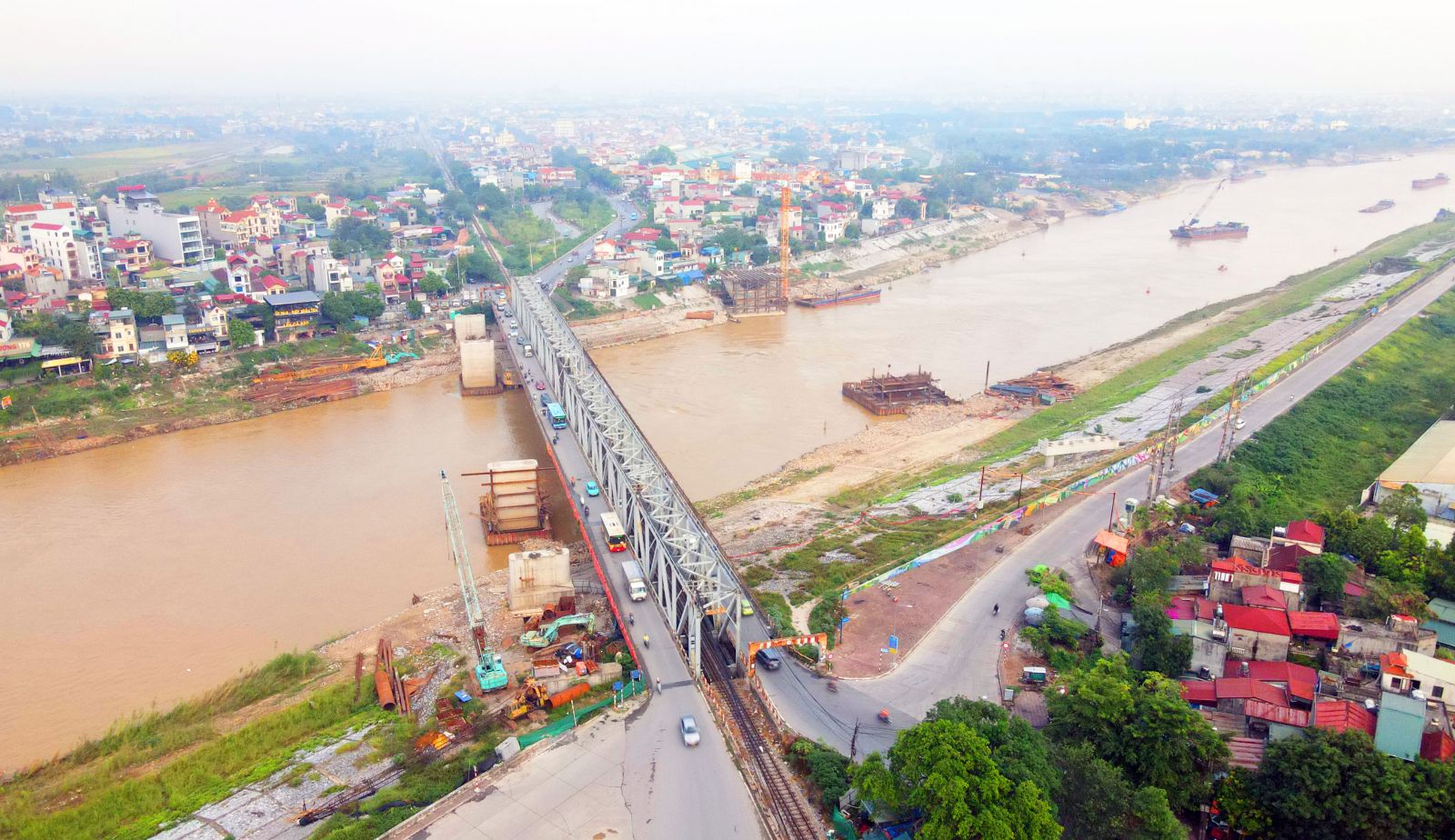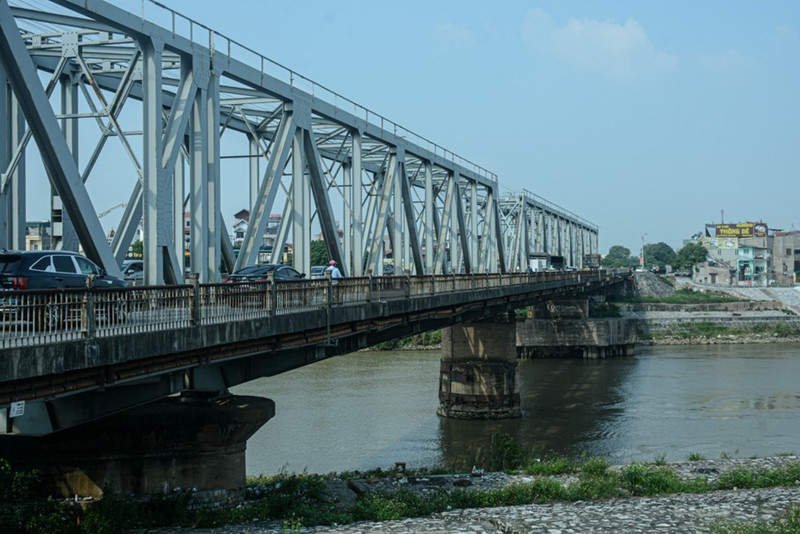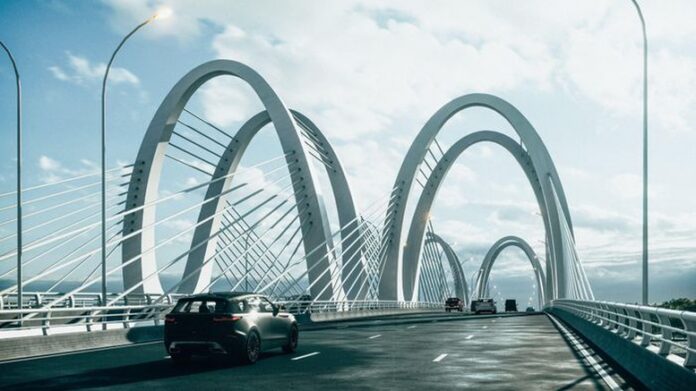New Duong Bridge Project at Risk of Delay
The construction project for the new Duong Bridge, a key infrastructure project connecting Long Bien district and Gia Lam district, is facing potential delays in meeting its 2025 completion schedule due to challenges in land clearance.
Approved in 2022, with a total investment of over VND 1,800 billion, the new Duong Bridge project is managed by the Railway Project Management Board under the Ministry of Construction. The bridge consists of two separate structures: a road bridge and a railway bridge, approximately 100 meters apart, spanning the Duong River. The modern design incorporates increased clearance for improved inland water transport capacity along National Inland Waterway Route No.1.

Artist’s impression of the future Duong River Bridge – Image source: Railway Project Management Board
The road bridge, with a length of 382 meters, features a combination of prestressed concrete and cable-stayed construction. It accommodates six lanes with a width of 18.5 meters and a designed speed of 80 km/h. The bridge is complemented by approximately 700-meter-long approach roads connecting vital intersections. Meanwhile, the railway bridge spans 1 kilometer, comprising six steel girders with a length of 280 meters, suitable for both 1,000 mm and 1,435 mm rail gauges, and a maximum speed of 80 km/h. It is also aligned with the planning of Hanoi’s Urban Railway Line No.1.
With construction commencing in July 2024, the project aimed for completion in 2025. However, land clearance has encountered significant challenges, as only approximately 4,000 square meters of public land, garden land, and green space have been handed over by the People’s Committees of Long Bien district and Gia Lam district. The remaining area of over 49 hectares has yet to be transferred, hindering the construction of the approach roads and viaducts. Currently, only the works on the river-crossing section, including piers T4 and T5, are underway, with expected completion in the second quarter of 2025.

The new Duong Bridge project faces delays. Image source: Urban Forum
The Project Management Board has repeatedly petitioned the Hanoi People’s Committee to address these obstacles, but viable solutions remain elusive. As a result, the project is facing the prospect of a temporary halt in construction from July 2025 due to the lack of available land. If this situation persists, completing the Duong Bridge by the targeted deadline will be highly challenging, significantly impacting inter-provincial transportation and connectivity in the northeastern region of the capital, as well as economic and social development.
The new Duong Bridge plays a crucial role not only in alleviating traffic pressure on National Highway 1A and the Hanoi-Dong Dang railway line but also in enhancing water transport capacity and fostering sustainable development in the area. Therefore, promptly resolving land-related challenges to ensure the project’s progress is an urgent task that requires coordinated efforts from various levels of government and concerned agencies.
Duong Bridge: A Witness to History’s Ups and Downs
Spanning the Duong River and connecting its two banks, the Duong Bridge is not just a vital transportation link but also a historical landmark deeply intertwined with the history of Northern Vietnam for over a century. Constructed in 1902, it is one of the region’s oldest bridges, serving both road and rail traffic on the critical Hanoi-Lang Son axis.
The original bridge comprised five spans, two abutments, and five piers. The abutments and piers featured well-type foundations capable of withstanding a flow rate of 4,500 cubic meters per second. The central span was a swing bridge, sitting on Pier 3, which was circular in shape. This design allowed for easy passage of watercraft by rotating the span when necessary. The bridge was oriented at an angle of approximately 45 degrees to the river flow direction.
During the war, the Duong Bridge was damaged by American bombing raids. Temporary repairs were made by reinforcing the piers and replacing the spans. As a result, the central swing span was replaced, and the bridge no longer had this unique feature.

Duong Bridge, built in 1902, is a vital link between Long Bien district and Gia Lam district in Hanoi. Image source: GDTĐ
Over its more than 120 years of service, the Duong Bridge has endured the vicissitudes of history, from wartime struggles to economic development, becoming a living testament to Hanoi’s and the Northeast region’s transformation. Its structure bears the architectural imprint of the French colonial era, retaining its unique technical and cultural value despite undergoing numerous repairs and maintenance works.
The bridge continues to play a significant role in the long-term transportation network, serving as a crucial link on the old national highway and the vital railway line, accommodating thousands of vehicles and passengers daily. Additionally, it stands as a cultural and historical landmark, attracting locals and tourists alike, preserving memories of the past.
However, after decades of use, the Duong Bridge has deteriorated and no longer meets the demands of modern transportation. With a limited clearance of only 2.8 meters during the high-water season, a narrow waterway span of 26 meters, and a narrow deck, the bridge struggles to handle increased traffic volumes, leading to congestion and safety concerns. Moreover, it no longer complies with current inland waterway transportation standards.
Plans to construct a new Duong Bridge are underway to replace the aging structure, ensuring safer and more modern transportation while meeting the region’s evolving needs. Nonetheless, the old Duong Bridge remains cherished as a symbol that connects the historical and future landscapes of Hanoi.
“Hanoi: Over a Ton of Fried Chicken Feet Seized of Unknown Origin”
“Authorities in Hanoi intercepted over a ton of fried chicken feet of unknown origin, packaged in sacks and en route to the capital for consumption. The traffic police department, in collaboration with the city’s public security units, successfully apprehended the culprits and seized the illicit cargo.”
“Why Son Hai Corporation was Excluded from the 880 Billion VND Highway Project”
“A recent evaluation report on the tender package for the construction of the Ho Chi Minh City – Thu Dau Mot – Chon Thanh Highway, passing through Binh Phuoc Province, revealed that the Son Hai Group was disqualified due to failing to meet technical requirements. On May 26th, the Son Hai Group issued an official letter protesting the contractor selection outcome.”





















